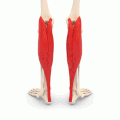| Gastrocnemius muscle | |
|---|---|
 Right leg seen from behind. | |
Dissection video (2 min 44 s) | |
| Details | |
| Pronunciation | /ˌɡæstrɒkˈniːmiəs/ or /ˌɡæstrəkˈniːmiəs/ |
| Origin | Proximal to articular surfaces of lateral condyle of femur and medial condyle of femur |
| Insertion | Tendo calcaneus (Achilles tendon) into mid-posterior calcaneus |
| Artery | Sural arteries |
| Nerve | Tibial nerve from the sciatic, specifically, nerve roots S1–S2 |
| Actions | Plantar flexes foot, flexes knee |
| Antagonist | Tibialis anterior muscle |
| Identifiers | |
| TA98 | A04.7.02.044 |
| TA2 | 2657 |
| FMA | 22541 |
| Anatomical terms of muscle | |
The gastrocnemius muscle (plural gastrocnemii) is a superficial two-headed muscle that is in the back part of the lower leg of humans. It is located superficial to the soleus in the posterior (back) compartment of the leg. It runs from its two heads just above the knee to the heel, extending across a total of three joints (knee, ankle and subtalar joints).
Contents
- Structure
- Origin/proximal attachment
- Insertion/distal attachment
- Relations
- Variation
- Function
- Motor pathway
- Clinical significance
- History
- Additional images
- See also
- References
- External links
The muscle is named via Latin, from Greek γαστήρ (gaster) 'belly' or 'stomach' and κνήμη (knḗmē) 'leg', meaning 'stomach of the leg' (referring to the bulging shape of the calf).




